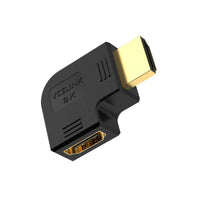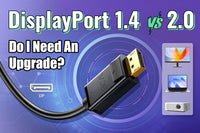If you buy a modern monitor, you may notice that it is labeled with “DSC Supported.” What does DSC mean? Display stream compression is an essential part of modern displays, including HDMI, DisplayPort, and USB-C. This technology provides visually lossless compression for UHD displays, improving bandwidth efficiency without reducing resolution and refresh rates. Explore our detailed blog for all the insights about DSC (Display Stream Compression).
What is Display Stream Compression (DSC)?
Developed by the Video Electronics Standards Association (VESA) in 2014, display stream compression (DSC) is a video compression technology designed to solve the limited bandwidth of different physical interfaces. It provides lossless video compression based on the YCoCg color space technology, ensuring visual quality based on ISO/IEC 29170 standards. While “lossless” in this context doesn’t imply mathematically perfect reproduction, the technology can ensure that human eyes see no differences between compressed and uncompressed content.
DSC 1.0 was the foundation of Display Stream Compression and DSC 1.1 refined some parts of the initial version. Then DSC 1.2 was introduced with DisplayPort 1.4 standard on 27 January 2016 and can be used with HDMI 2.1 to support up to 8K resolution; DSC 1.2a was introduced on January 18, 2017 and was upgraded from 1.2 to 1.2a by DisplayPort 1.4a, but it only made some minor changes, such as the native encoding of the 4:2:2 and 4:2:0 formats, color bits, and so on.
How Does it Work?
Display stream compression (DSC) converts video data from RGB formats to YCoCg color space, isolating brightness information from color. Then, it uses delta PCM (differential pulse-code modulation) to predict pixels and only encodes the different ones, reducing the amount of data transmitted. DSC technology remains visually lossless, meaning that human eyes cannot perceive differences between uncompressed and compressed content.
Advantages and Disadvantages of DSC
Display stream compression is useful for high-resolution displays but also adds latency to video signals. Let’s delve into the advantages and disadvantages of DSC in the following section.
Advantages
- High Resolution & Refresh Rates: Using DSC increases the bandwidth capabilities of DisplayPort and HDMI, enabling support for high resolution, high refresh rate, and better HDR brightness. DP 1.4 with DSC High Bit Rate 3 (HBR3) can support 8K resolution at 60 Hz or 4K resolution at 240 Hz and HDR and HDMI 2.1 with DSC can support 8K up to 120 Hz with HDR.
- Optimized for Multi-monitor Setup: DSC also makes the multi-monitor configuration more practical. Most large video walls such as computer monitors, television sets, and control room monitoring consist of multiple display devices that transmit large amounts of display data. With DSC, these setups can display HD content without requiring additional cables or connectors.
- Enhanced Color Depth: DSC can ensure high image quality with its support for advanced color depth. DSC supports 10 or 12 bits of color at higher resolution. The latest DSC 1.2a has upgraded to a color depth of 14 and 16 bits, offering richer and more precise colors.
- Enhanced HDR: DSC also enhances HDR transfer efficiency through intelligent entropy redistribution. HDR’s higher color depth and broader luminance ranges result in larger data volumes, but DSC can compress data more efficiently without losing visual information.
Disadvantages
- DSC will take a few milliseconds to buffer the entire image frame, which may cause a slight delay when loading video signals;
- DSC requires the compatibility of input and output devices. For example, output devices lacking decoding capability will display a lower resolution;
DSC bitstream specifications vary across different vendors, meaning that devices from different manufacturers may not work seamlessly together.
DSC with DisplayPort, HDMI, and USB
|
DSC with DisplayPort |
DSC with HDMI |
DSC with USB |
|
|
4K Display |
DP 1.4 with DSC HBR3: Up to 240 Hz |
HDMI 2.1 with DSC 1.2: Up to 120 Hz |
USB 4.0 with DSC 1.2a: Up to 120 Hz |
|
DP 2.0 with DSC 1.2a: Up to 240 Hz |
|||
|
8K Display |
DP 1.4 with DSC HBR3: Up to 60 Hz |
HDMI 2.1 with DSC 1.2: 8K up to 120Hz |
USB 4.0 with DSC 1.2a: Up to 120 Hz |
|
DP 2.0 with DSC 1.2a: Up to 120Hz |
DSC over USB-C
USB-C with DSC technology will play an important role in the future. USB-C and Thunderbolt can support higher resolution and refresh rates with VESA DSC and through DisplayPort for video and audio transmission in DP Alt Mode.
With DP 1.4 and DSC, you can connect three 4K displays by using a single USB-C hub and enable 8K by using USB-C and Thunderbolt 3. But with the latest DP2.0/2.1 alt mode, you can enable higher resolution and refresh rate by using new USB-C connections.

Do I Need Display Stream Compression (DSC)?
Modern displays generally come with DSC enabled by default, so you may already be benefiting from display stream compression (DSC). In fact, whether you need DSC depends on your use cases, hardware, and resolution requirements.
If you’re a gaming or home theater enthusiast, DSC is essential to improve your viewing experience. You can enjoy superior visual quality while reducing bandwidth demands. For improved HDR effects, DSC 1.2 or 1.2a is recommended.
If you’re a professional using multi-monitor setups for video walls or control rooms, you may benefit from DSC to simplify cabling.
For your automotive displays, DSC’s low latency will be crucial for your safety-critical display in your cars because it ensures that you will see what the camera is capturing for your safe driving.
For conferences, enabling DSC on a multi-monitor display helps compress high-resolution content, ensuring low latency on the projection system.
In AR/VR applications, DSC plays a critical role in reducing latency between physical movement and the display on head-mounted devices (HMDs), preventing motion sickness.
Final Words
Display stream compression or DSC enables high resolution and refresh rates across different display interfaces, enhancing visual quality with minimized bandwidth requirements. It is supported by most DP, HDMI, and USB cables or connectors. Looking ahead, the next generation of DSC will play a crucial role in audio-visual (AV) or augmented reality (AR) applications. Whether you use it or not, it has probably become a default feature.
For more information on this topic, you can keep up on our blogs. While VCELINK offers general and basic information for our customers and other visitors to the website, it’s not professional advice.






Be the first one to comment.
Leave a comment